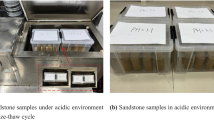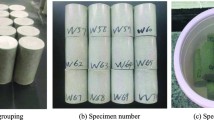Abstract
Long-term exposure to chemical solutions can change the mineral composition and microstructure and may seriously affect the physical and mechanical properties of rocks. Therefore, to clarify the effects of long-term exposure and types of acids on the mechanical properties of rocks, and to develop the constitutive model of acid-immersed rocks, uniaxial compression tests were carried out on acid-immersed sandstone specimens. The sample weakened, and the brittle failure behavior became more ductile by the acid immersion to the aqueous solution of hydrochloric or sulfuric acids. The duration of the compaction stage of the stress–strain curve increased, that of the elastic stage decreased; the peak stress, elastic modulus, and Poisson's ratio decreased, and the peak point strains increased with the acidity and the immersion duration. The brittle shear failure of the untreated specimen became more axial splitting type failure with acidity. The damage variable of the combined effects of chemical and stress was introduced, and a statistical damage model considering the compaction stage of the stress–strain curve was established based on the damage variable. The model well-simulated the experimentally obtained stress–strain curves of the acid-immersed specimens. Finite element models reflecting the characteristics of the acid-immersed sandstone were established based on CT images.












Similar content being viewed by others
Abbreviations
- D:
-
Damage variable of the sample under the combined action of chemistry and load
- D C :
-
Damage variable of the sample attacked by acid solution
- D C 1 :
-
Damage variable of the corroded area
- D C 2 :
-
Damage variable of the uncorroded area
- D m :
-
Damage variable of the sample caused by loading
- E :
-
Elastic modulus
- E(ρ 1):
-
Mathematical expectations of ρ1
- E(ρ 2):
-
Mathematical expectations of ρ2
- F 0 :
-
Weibull distribution parameter
- H :
-
CT number of the sandstone
- H 1 :
-
CT number of the sandstone in the corroded area
- H 2 :
-
CT number of the sandstone in the uncorroded area
- H r :
-
CT number of the sandstone matrix.
- m :
-
Weibull distribution parameter
- ΔV :
-
Volume change
- V e :
-
Elastic volume
- ε v :
-
Volumetric strain
- ε A :
-
Axial strain
- ε L :
-
Radial strain;
- ε ve :
-
Elastic volumetric strain
- ε vc :
-
Fracture volumetric strain.
- σcc :
-
Crack closure stress
- σc :
-
Crack initial stress
- σcd :
-
Damage stress
- σf :
-
Peak intensity
- σ i :
-
I-th principal stress
- ε i :
-
Strain corresponding to σi
- ν :
-
Poisson's ratio
- φ :
-
Internal friction angle
- σ*:
-
Effective stress
- ρ :
-
Density of the sandstone
- ρ 1 :
-
Density of the corroded area of the sandstone
- ρ 2 :
-
Density of the uncorroded area of the sandstone
- ρ r :
-
Density of the sandstone matrix
- ρ 0 :
-
Density of the non-damaged sandstone
References
Ammouche A, Riss J, Breysse D, Marchand J (2001) Image analysis for the automated study of microcracks in concrete. Cement Concrete Comp 23:267–278
Andrä H et al (2013) Digital rock physics benchmarks—part I: imaging and segmentation. Comput Geosci 50:25–32
Atkinson BK, Meredith PG (1981) Stress corrosion cracking of quartz: a note on the influence of chemical environment. Tectonophysics 77:T1–T11
Cao W-g, Zhao M, Liu C (2004) Study on the model and its modifying method for rock softening and damage based on Weibull random distribution. Chin J Rock Mech Eng 23:3226–3231 (In Chinese)
Dequiedt A-S, Coster M, Chermant L, Chermant J-L (2001) Study of phase dispersion in concrete by image analysis. Cement Concrete Comp 23:215–226
Fairhurst C, Hudson J (1999) Draft ISRM suggested method for the complete stress-strain curve for intact rock in uniaxial compression. Int J Rock Mech Min Sci 36:279–289
Feng X-T, Chen S, Li S (2001) Effects of water chemistry on microcracking and compressive strength of granite. Int J Rock Mech Min Sci 38:557–568
Feng X-T, Chen S, Zhou H (2004a) Real-time computerized tomography (CT) experiments on sandstone damage evolution during triaxial compression with chemical corrosion. Int J Rock Mech Min Sci 41:181–192
Feng XT, Li SJ, Chen SL (2004b) effect of water chemical corrosion on strength and cracking characteristics of rocks-a review. In: Key Eng Mater. Trans Tech Publ, pp 1355–1360
Feucht L, Logan JM (1990) Effects of chemically active solutions on shearing behavior of a sandstone. Tectonophysics 175:159–176
Gao F, Wang Q, Deng H, Zhang J, Tian W, Ke B (2017) Coupled effects of chemical environments and freeze-thaw cycles on damage characteristics of red sandstone. B Eng Geol Environ 76:1481–1490
Garboczi EJ, Cheok GS, Stone WC (2006) Using LADAR to characterize the 3-D shape of aggregates: preliminary results. Cement Concrete Comp 36:1072–1075
Grgic D, Giraud A (2014) The influence of different fluids on the static fatigue of a porous rock: Poro-mechanical coupling versus chemical effects. Mech Mater 71:34–51
Hall SA, Bornert M, Desrues J, Pannier Y, Lenoir N, Viggiani G, Bésuelle P (2010) Discrete and continuum analysis of localised deformation in sand using X-ray μCT and volumetric digital image correlation. Géotechnique 60:315–322
Han T, Shi J, Cao X (2016) Fracturing and damage to sandstone under coupling effects of chemical corrosion and freeze-thaw cycles. Rock Mech Rock Eng 49:4245–4255
Han T, Shi J, Chen Y, Li Z, Li C (2017) Laboratory investigation on the mechanical properties of sandstone immersed in different chemical corrosion under freeze-thaw cycles. Chin J Solid Mech 38:503–520
Heggheim T, Madland M, Risnes R, Austad T (2005) A chemical induced enhanced weakening of chalk by seawater. J Petro Sci Eng 46:171–184
Hu D, Zhou H, Hu Q, Shao J, Feng X, Xiao H (2012) A hydro-mechanical-chemical coupling model for geomaterial with both mechanical and chemical damages considered. Acta Mech Solida Sin 25:361–376
Hua-Feng D, An-long H, Jian-lin L, Xiao-jing Z, Yu H, De-long C, Min Z (2017) Statistical damage constitutive model of sandstone under water-rock interaction. Rock Soil Mech 38:631–639 (In Chinese)
Huo R, Li S, Ding Y (2018) Experimental study on physicochemical and mechanical properties of mortar subjected to acid corrosion. Adv Mater Sci Eng 2018
Hutchinson A, Johnson J, Thompson G, Wood G, Sage P, Cooke M (1993) Stone degradation due to wet deposition of pollutants. Corros Sci 34:1881–1898
Ji Y, Hall SA, Baud P, Wong T-f (2015) Characterization of pore structure and strain localization in Majella limestone by X-ray computed tomography and digital image correlation. Geophys J Int 200:701–719
Karfakis M, Akram M (1993) Effects of chemical solutions on rock fracturing. Int J Rock Mech Min Sci 7:1253–1259
Latham J-P, Munjiza A, Garcia X, Xiang J, Guises R (2008) Three-dimensional particle shape acquisition and use of shape library for DEM and FEM/DEM simulation. Miner Eng 21:797–805
Li S, Huo R, Wang B, Ren Z, Ding Y, Qian M, Qiu T (2018) Experimental study on physicomechanical properties of sandstone under acidic environment. Adv Civ Eng 2018
Li S, Huo R, Fujii Y, Ren D, Song Z (2019) Effect of acid-temperature-pressure on the damage characteristics of sandstone. Int J Rock Mech Min Sci 122:104079
Lin C, Miller J (2005) 3D characterization and analysis of particle shape using X-ray microtomography (XMT). Powder Technol 154:61–69
Martin RJ III (1972) Time-dependent crack growth in quartz and its application to the creep of rocks. J Geophys Res 77:1406–1419
Ning L, Yunming Z, Bo S, Gunter S (2003) A chemical damage model of sandstone in acid solution. Int J Rock Mech Min Sci 40:243–249
Perez CA, Estévez PA, Vera PA, Castillo LE, Aravena CM, Schulz DA, Medina LE (2011) Ore grade estimation by feature selection and voting using boundary detection in digital image analysis. Int J Mine Process 101:28–36
Přikryl R (2001) Some microstructural aspects of strength variation in rocks. Int J Rock Mech Min Sci 38:671–682
Qu D, Li D, Li X, Yi L, Xu K (2018) Damage evolution mechanism and constitutive model of freeze-thaw yellow sandstone in acidic environment. Cold Reg Sci Technol 155:174–183
Reinhardt H, Mielich O (2014) Fracture toughness of alkali-sensitive rocks in alkaline solution. Int J Rock Mech Min Sci 70:552–558
Rutqvist J (2015) Fractured rock stress-permeability relationships from in situ data and effects of temperature and chemical-mechanical couplings. Geofluids 15:48–66
Taylor MA, Garboczi EJ, Erdogan S, Fowler D (2006) Some properties of irregular 3-D particles. Powder Technol 162:1–15
Tiwari B, Ajmera B (2011) A new correlation relating the shear strength of reconstituted soil to the proportions of clay minerals and plasticity characteristics. Appl Clay Sci 53:48–57
Townsend FC, Gilbert PA (1973) Test to measure residual strength of some clay scales. Geotechnique 23
Vazquez P, Carrizo L, Thomachot-Schneider C, Gibeaux S, Alonso FJ (2016) Influence of surface finish and composition on the deterioration of building stones exposed to acid atmospheres. Constr Build Mater 106:392–403
Xu X, Gao F, Zhang Z (2018) Thermo-mechanical coupling damage constitutive model of rock based on the Hoek-Brown strength criterion. Int J Damage Mech 27:1213–1230
Wang W, Liu T, Shao J (2016) Effects of acid solution on the mechanical behavior of sandstone. J Mater Civil Eng 28:04015089
Wang Y, Li C, Hu Y (2018) Use of X-ray computed tomography to investigate the effect of rock blocks on meso-structural changes in soil-rock mixture under triaxial deformation. Constr Build Mater 164:386–399
Acknowledgments
This work is supported by the National Key R&D Program of China (Grant No. 2018YFC0808701), the China Postdoctoral Science Foundation (Grant No. 2020M673525), the National Natural Science Foundation of China (Grant No. 41172237), the Shaanxi Province New-Star Talents Promotion Project of Science and Technology (Grant No. 2019KJXX-049) and the Research Project of China Railway 20th Bureau Group Co. Ltd. (Grant No. YF2000SD01A).
Author information
Authors and Affiliations
Contributions
SL: conceptualization, methodology, writing-original draft, investigation, data curation. YW: supervision, conceptualization, writing-review. RH: conceptualization, methodology, writing-review, and editing. ZS: investigation, formal analysis. YF: writing-review and polishing. YS: writing-review and polishing.
Corresponding author
Ethics declarations
Conflict of interest
The authors declare that they have no competing interests.
Additional information
Publisher's Note
Springer Nature remains neutral with regard to jurisdictional claims in published maps and institutional affiliations.
Rights and permissions
About this article
Cite this article
Li, S., Wu, Y., Huo, R. et al. Mechanical Properties of Acid-corroded Sandstone Under Uniaxial Compression. Rock Mech Rock Eng 54, 289–302 (2021). https://doi.org/10.1007/s00603-020-02262-5
Received:
Accepted:
Published:
Issue Date:
DOI: https://doi.org/10.1007/s00603-020-02262-5




